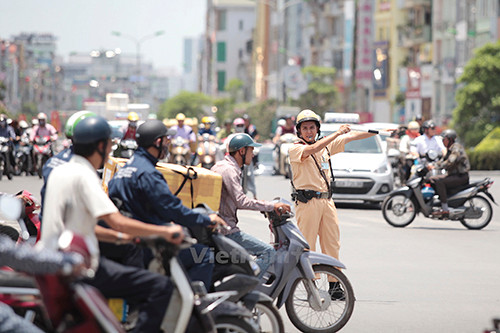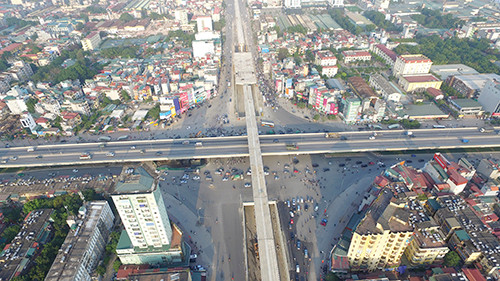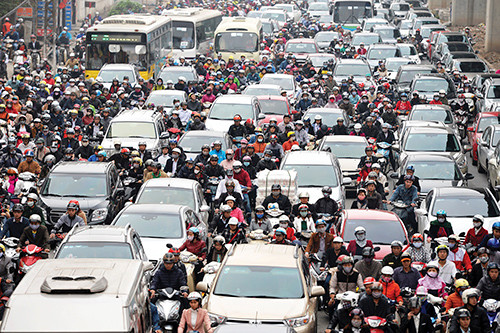Logistics solutions toreduce congestions for Hanoi
Thời sự - Logistics - Ngày đăng : 15:22, 17/04/2017
(Vietnam Logistics Review) Severe congestion in Hanoi has been a big problem, causing damages to both economy and society. In existing situation, it is almost impossible to have measures to solve the problem in short-term. For proper solutions, we have to find roots of the problem first.
There should be a revolution to the field of infrastructure management in general and to the field of traffic management in particular. Short - term solutions only solve a part of the problems. We think there should be both short - term and long- term logistics traffic measures for Hanoi.

Short- term solutions to reduce congestions in Hanoi
Restructuring the city transport system at junctions and road axis where there are congestions or where there is large amount of traffic
(1) Rechecking the existing traffic system and implementing connections from stations to stations, ports to stations, and to resident areas with means of transport.
(2) Reorganizing roads in the city and having more parking lots to avoid using pavements for parking lots or for street vending...
(3) Providing services for passengers at stations; restructuring static traffic network and resetting taxi stops.
(4) Soon completing elevated railroad network to reduce congestions for Hanoi.
(5) Stopping giving permission for building apartment buildings in the city districts. They should be located in the suburbs to make “new Hanoi”.
(6) Increasing the number of traffic policemen at congestion spots, using volunteers from universities if necessary.

Long - term, sustainable solutions for congestions
(1) Developing logistics infrastructure of Hanoi to 2025, including parts from transport plans, trading infrastructure plans, IT developments, capital development plans... Having long-term views, optimizing transport networks by investments.
(2) Developing underground system, elevated multi-level roads, and restoring tramp system...
(3) Planning the whole existing static traffic works to make them suitable to scale and development speed of the city, with more attention to underground static traffic system which Hanoi has advantages of.
(4) Planning and building logistics centers at capital gateways to connect bounded roads for stations for all means of transport, which will have functions as delivery centers like those from other countries as Germany, Holland or Japan; avoiding unloading travel in the city; establishing city logistics transaction floor for exchanging information among means of transport owners for more effective use of means of transport and transport infrastructure.

(5) Investing in and expanding road junctions, speeding up road construction as planned; avoiding planning, investing in, building road junctions in type of “term”.
(6) Upgrading training on sense of implementing transport rules for people traveling in the city area.
We will mention 10 basic reason from the logistics point of view: 1. There is a lack of logistic system plan in general and logistics infrastructure plan in particular with long-term view to connect with plans from various sectors and districts in the city area. As the result, these plans “mince” Hanoi (as the City Chairman Nguyen Duc Chung once said) 2. Current congestions is dearly bought of the plan that lacked long-term view and of the improper implementation... 3. The lack of long- term logistics plan resulted in ineffective operation of transport infrastructures and trade infrastructures... The root reason is the lack of connections among infrastructures: the lack connections from means of transport to stations, from stations to stations and from stations to resident areas... 4. The use of public transport is limited: there is only the use of bus. From the beginning, Hanoi made a mistake when removing the tramp system that was being used for 100 years. The system was designed to connect to resident areas of Hanoi- the matter having been considered when the system was designed. We removed it without anything to replace. The use of pneumatic tramp was fail and now, there is the use of BRT (Bus Rapid Transport). The use of tramp has been maintained in many countries worldwide, especially in Europe as an economically and socially effective type of transport. 5. Although large amount of money has been paid for anti-congestion solutions. They did not work well after a time: cross-over bridges, underground cross-over... and the construction of elevated railway is too slow- a waste of budget and effort. All the works are done with short-term view or as expedient solutions. 6. The city static traffic system is weak, almost nothing so far. Taxi stations and stops in the city area have not been planned. Goods and passengers transport services are weak. For example, Hanoi railroad station causes offensive feelings for passengers. 7. There are no logistics centers with appropriate scale with bounded roads and national roads to the city serving as stations and delivery centers to reduce the number of vehicles to the city and thus to reduce accidents too. In the plan of development of Hanoi city to 2030, vision to 2050, two logistics centers in Soc Son and Thuong Tin are not enough and it is still unknown when the projects start. Stations were not well designed, causing inconvenience to passenger and goods transport, pushing logistics costs high. 8. Too many high apartment buildings in the city. And only commercial factors, not transport infrastructures, were paid attention to. Places of factories or stations which had been removed to sub-urban with “environment” reasons were permitted to build apartment buildings. Apartment buildings everywhere, together with increasing population, have made the traffic infrastructure overloaded. Congestions indeed are unavoidable. 9. The need for transport has increasing. But only bus has been the mean of public transport for the last 30 years. Bad services from staff, bad quality,weak security have reduced the number of passengers. 10. The sense of law obedience is limited and the police force has not well functioned, sometimes they also cause inconvenience to people. |
